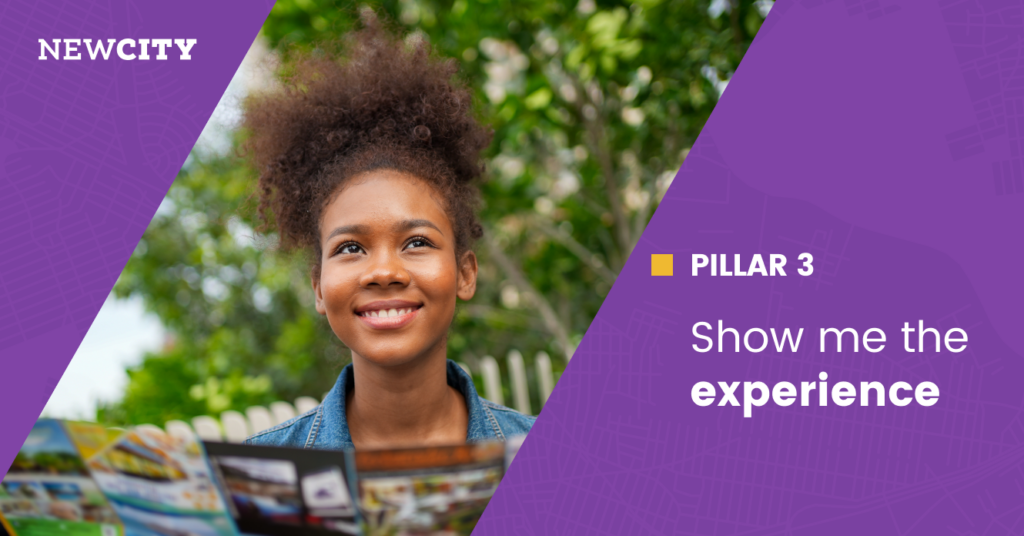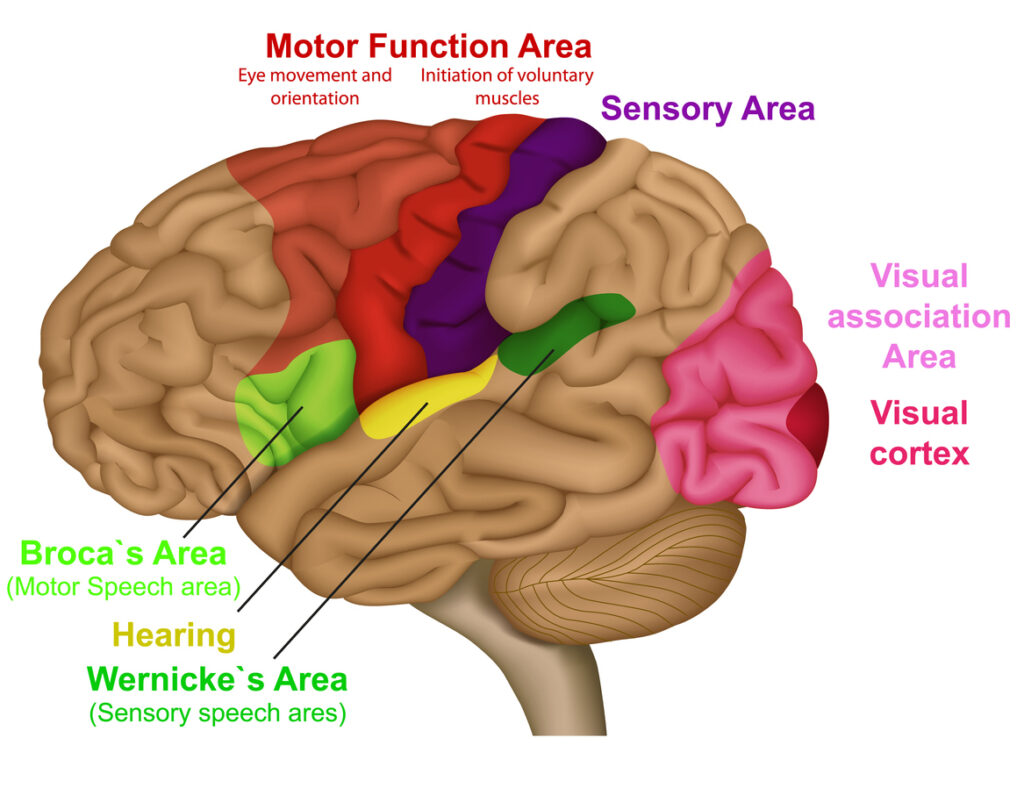The third of NewCity’s Seven Pillars of Higher Ed Digital Strategy is Show Me the Experience. The “what” of this idea is simple – prospective students want to know what it’s really like at your school, and whether it’s right for them.
The “how” is more nuanced. What works to convey this? What sort of content sparks the imagination? What’s believable?
The questions most students are asking
In our research we see these questions on the minds of students. They’re not looking in one place to answer them, and they may not even be asking them consciously. But every part of your website, your admissions materials, videos they’re watching on social media, conversations with family and friends – are helping to answer them.
- What does the campus look like?
- What are the other students like? Would I fit in? Feel welcome?
- Where would I live? What are the dorm rooms like?
- What’s the food like?
- What would my day to day life be like?
- What could I do outside of class? Are there people who like doing the same stuff as me?
- What is the town / community / city around the school like?
- Is it safe?
- How easy is it to get around?
- Do I need a car?
- What’s the weather like?
Again – they’re going to go anywhere and everywhere to answer these questions. Don’t think you can answer them in a walled garden admissions site. Prospective students assume every part of your website is for them. They’re just as likely to go poking around in your alumni pages or your campus calendar to find answers.
How do you answer?
We’ve found these five ideas to be powerful guides for your strategy to show students what their journey could be like.
1. Journeys start in the mind.
People never willingly do something new that they haven’t first imagined themselves doing. Think about it. If someone asks you if you want to get lunch together, you picture yourself eating together before you say “yes.” You imagine yourself driving a certain car, or taking a certain vacation, before you make a buying decision.
So our goal with prospective students is to help them imagine being a student at our school – creating an experience in their mind that is not only vivid but more appealing than the other schools on their list.
Often the first school to do this well is the one they choose.
To reach the imagination, a little understanding of the brain goes a long way. Imagination happens in the front of your brain, the prefrontal cortex. But our brains take in a LOT of input during the day, and they’re amazingly good at filtering out the “blah blah.” There’s even an area of your left hemisphere (Broca’s Area) that predicts patterns and serves as a gatekeeper, keeping your prefrontal cortex from getting overwhelmed and distracted.
2. Words can make pictures.
You might think the obvious way to reach the imagination is to use photos and video, and you’re not wrong. But let’s start with words. Words have incredible power to spark the imagination. Unfortunately we spend a lot of time on content that never gets past the gatekeeper.
Brain science points to several ways we can use words to wake up the imagination. None of these are about manipulation – it’s just good communication.
- Action verbs – these immediately evoke some picture of the action, bringing you one step closer to the imagination.
- Stories – characters, setting, action; you can’t help but imagine!
- Surprises – an unusual turn of phrase, a plot twist, a punchline.
- Humor – combines storytelling and surprise, highly memorable.
- Poetry – poetic meter changes words into music, which we process in the right hemisphere, bypassing Broca the gatekeeper entirely.
- Leave something to the imagination – writing like Hemingway, say just enough enough and let readers fill in the rest.
Brain science also shows us that adrenaline is an essential ingredient if we want something to be stored in long-term memory. Evoking any sort of emotional response helps this. So stories, surprise, humor – all are powerful tools.
Stories don’t have to be long – you can tell a story in a single sentence. Here’s an example. A university known for its graduate programs for teachers writes:
“These programs have wonderful features: weekend schedules, convenient locations and a focus on effective teaching practices.”
The main character in this story is the university. But should it be? What happens if we put the teacher in the middle of the story, and help them imagine taking this action…
“These teachers loved the practical advice and lesson plans they could apply in their own classrooms; what they learned over the weekend could be used immediately the following week.”
or as a teaser link:
“On a future Monday, your classroom will come alive with new energy and ideas. Here’s why…”
Notice the appeal to what’s on every teacher’s heart. What do teachers care about? Engaged students.
3. Find a vivid “First Mental Image.”
Novelists spend a lot of time crafting the first page, the first paragraph, the first sentence of their story. How can they hook the reader from the first words?
One technique you’ve probably seen is to drop the reader into the middle of a dramatic point in the action. They use words that put you right in the scene – you may not know what’s going on yet, but you read further to find out. Then the author steps back to tell the beginning of the story.
This is an example of using a powerful “first mental image.” Find a high point, full of vivid action and emotion, and start there.
I love this example from Ralph Berrier Jr., in a series of newspaper articles he wrote about Virginia’s bluegrass heritage several years ago. He started with:
“I am standing at the grave of my grandfather. A summer storm is gathering in the west beyond the Blue Ridge. A bronze flat headstone rests in the grass. It reads with the directness of a soldier’s dog tag.
Clayton Hall
S/Sgt. U.S. Army
World War II
May 4, 1919-April 22, 2003
Purple Heart”
You read that and you’re right there with him, feeling what he feels as he contemplates his grandfather’s story.
One of the ways we search for those powerful mental images is to ask people to “Think of a person or story that shows your school / department / program at its best.” In a workshop we ask people to take 10 minutes to write down this story or write about this person, then share it with a partner. Then we share with the larger group. From here you can decide which of these stories convey your brand experience in an authentic way, and how these stories can be best applied in your content strategy.
4. Show, don’t tell.
Often when we write, we have something we believe, and we want other people to believe it too. Persuading prospective students that your school is right for them is just one scenario.
Here’s one of my favorite examples for teaching this idea. Someone at a university wrote this paragraph to promote their study abroad program:
“The Spoleto Study Abroad Summer Session is an intensive interdisciplinary program focusing on the arts and humanities for high school students, ages 15-19, interested in instrumental or vocal music, visual arts, photography, creative writing or drama. Students are given the opportunity to explore their academic and artistic interests through exposure to an integrated style of learning in a unique European setting. The mission of the program is to provide a challenging and innovative experience for students who have the desire to expand their knowledge while immersed in a diverse and vibrant culture.”
I’ve bolded all of the adjectives. These are the first place to look to see what you’re trying to persuade people to believe. Several of these are common higher ed buzzwords.
Are you convinced just by reading this paragraph that all these things are true? What other content could you put with this paragraph that demonstrates “intensive interdisciplinary” or “integrated” or “challenging” or “innovative”? Maybe:
- video and examples of student creative work
- a journal entry from a student describing their day
- photos of students in these settings
- an outline of the curriculum week by week
Any of these would show the Spoleto Study Abroad experience. This is a perfect example of what we mean when we say show, don’t tell.
Roy Williams defines “Show Don’t Tell” this way in his book The Wizard of Ads.
“If you want the truth to prevail, you must cause people to realize the truth. This requires much more skill than is required to simply tell it… The truth we are told is truth we may not accept; the truth we have realized is the only truth we own.”
To do this, you give people sensory details and substantive facts that support the truth you want to communicate. Then let them come to their own conclusions. When they do, they’ll realize them with far greater conviction.
The challenge is that it takes more work to develop this content. It’s easier to write that Spoleto paragraph than to source all the supporting “show” material. So content creators have to choose wisely where to put their energy. The alternative is to leave people unconvinced.
This excerpt from Emory University School of Medicine’s writing guide gives writers tips on what they can show, to demonstrate the School of Medicine’s key brand messages.
|
THEME |
Challenging Conventions |
Discovery/Creativity |
Deep Experience/Preparedness |
|---|---|---|---|
| TALK ABOUT EXAMPLES OF |
|
|
|
| USING THINGS LIKE |
|
|
|
5. Make Inukshuk.
I love this one because the word makes me happy. Inuit peoples have all the best words.
An inukshuk (pl. inuksuit) is a stone formation traditionally built by the Inuit. Originally spelled inuksuk, the word inukshuk means “to act in the capacity of a human.” (from Cultural Elements blog)
Maybe you’ve seen one of these rock piles on a hike. At their core they show that another human was here, someone like you has gone this way before.
Inukshuk content is anything that shows us someone like us having the experience before us, giving us comfort that we can do it too. Those “day in the life” videos, student testimonials, stories of faculty working with students to do something interesting – all of these are inukshuks.
Credit where its due
I learned ideas 1 – 4 from Roy Williams, author of the Wizard of Ads trilogy and founder of a you’ve-got-to-see-it-for-yourself-to-believe-it school of communications outside Austin, Texas called the Wizard Academy. You can read the trilogy for free at http://www.rhw.com/youll-laugh-youll-cry/
Jared Spool and Christine Perfetti introduced me to the Inukshuk concept in one of their many amazing presentations. Christine writes about it here: https://articles.centercentre.com/inukshuk_content/
Ralph Berrier, Jr. went on to write a book about his grandfather and great uncle, and their contributions to bluegrass music, titled If Trouble Don’t Kill Me https://a.co/d/1taovaR
Let's talk content strategy!
If you enjoyed these ideas and think NewCity could bring a fresh approach to your content strategy, talk to us! We teach workshops on these methods, and we partner with our clients to plan and deliver this sort of content.

David is the founder and president of NewCity. He teaches workshops on UX and content strategy.



